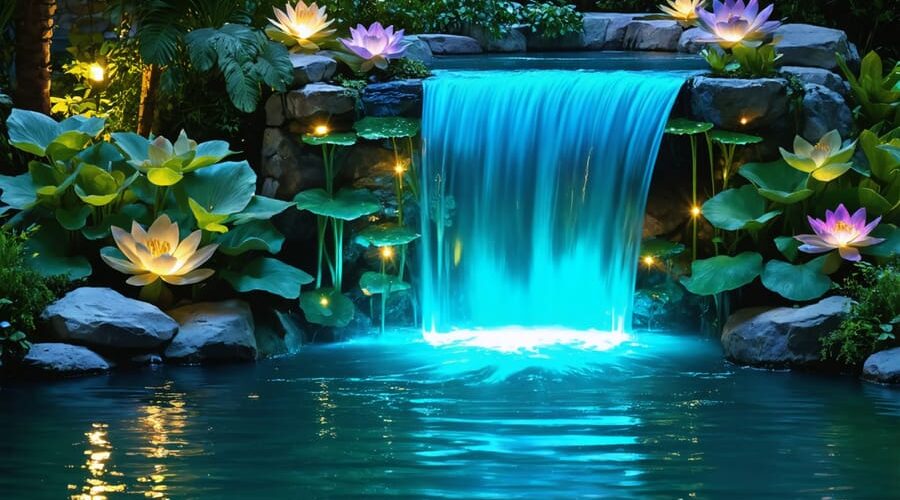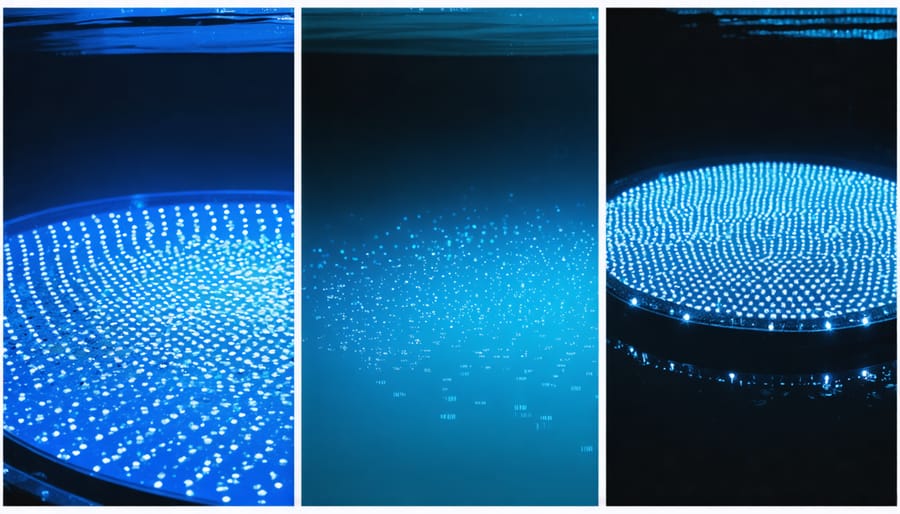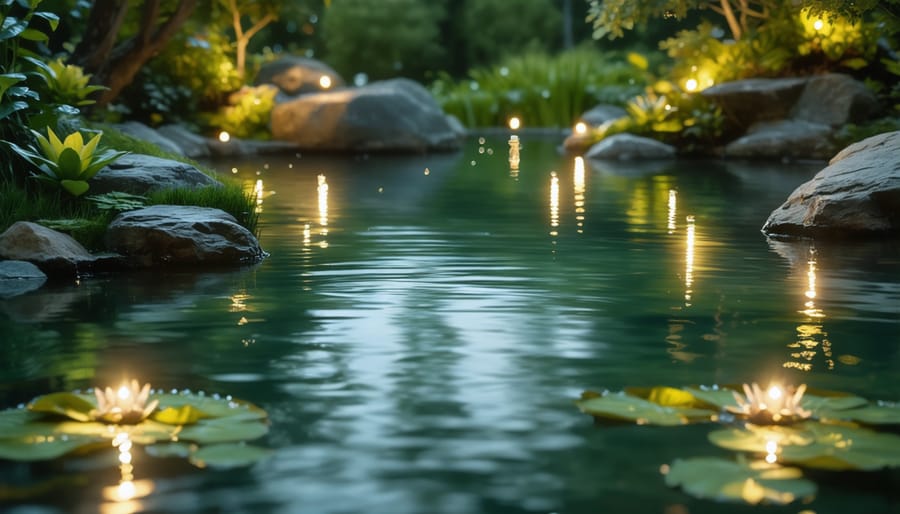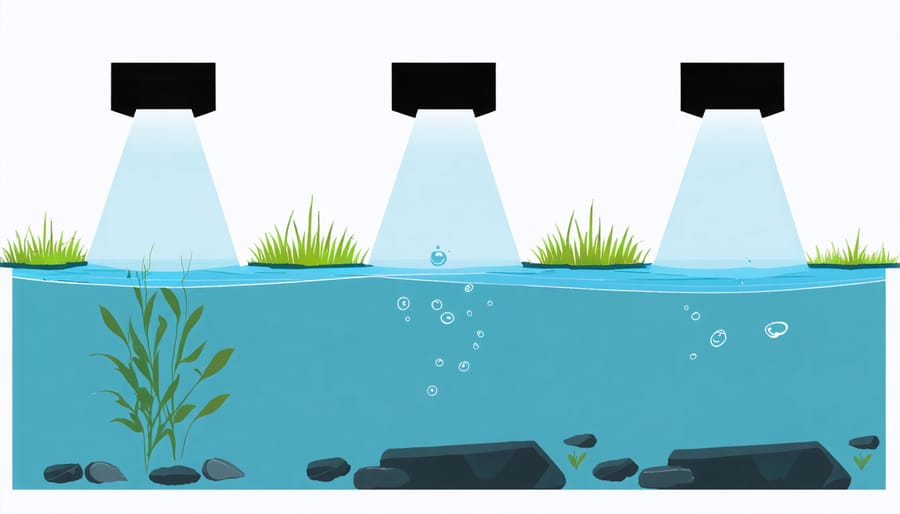
Transform Your Pond After Dark: Seasonal Underwater Lighting That Brings Magic Year-Round
Transform your pond into a mesmerizing nighttime showcase with strategically placed underwater landscape lighting. Position LED spotlights beneath waterfalls to create dramatic cascading effects, while submerged color-changing fixtures near aquatic plants cast ethereal shadows across the water’s surface. Install low-voltage lighting systems 12-18 inches below the waterline to illuminate fish movements and architectural features without overwhelming the natural ambiance.
Master the art of layered lighting by combining deep-water spots for overall illumination with shallow accent lights that highlight specific features. Weather-resistant LED systems not only provide energy-efficient brilliance but also require minimal maintenance while lasting up to 50,000 hours. Carefully angle lights away from seating areas to prevent glare and enhance the viewing experience from multiple vantage points.
Control seasonal dynamics by adjusting light positions and intensity to compensate for changing water levels and plant growth. During winter, redirect lights to showcase ice formations and maintain visual interest when aquatic life is less active. Simple timer systems automate operation while motion sensors add an interactive element, creating a dynamic display that transitions seamlessly from dusk to dawn.
Essential Underwater Lighting Basics
Types of Underwater Lights
When exploring best pond lighting options, you’ll find three main types to choose from. LED lights are the most popular choice, offering excellent energy efficiency and longevity. These modern fixtures use minimal electricity while providing bright, clear illumination that can last up to 50,000 hours. They’re also available in various colors and can be easily controlled with smart systems.
Halogen lights, though older technology, remain a reliable choice for pond owners seeking warm, natural lighting. They create a cozy ambiance and typically cost less upfront than LEDs, but they do consume more energy and need more frequent replacement. Their warmer light spectrum can make fish colors appear more vibrant and natural.
Fiber optic lighting offers a unique solution for pond illumination. These systems use a single light source that distributes light through multiple small cables, allowing for creative lighting designs with minimal underwater hardware. While they’re typically more expensive initially, fiber optic lights are incredibly safe, produce no heat in the water, and require minimal maintenance. They’re perfect for highlighting specific features or creating subtle lighting effects around your pond.

Safety and Power Considerations
Safety should always be your top priority when installing underwater pond lighting. Always use fixtures specifically rated for underwater use, with an IP68 waterproof rating that ensures complete protection against water immersion. Low-voltage systems (12V or 24V) are strongly recommended for pond lighting, as they’re much safer than mains voltage options and reduce the risk of electrical accidents.
When installing your lights, ensure all cable connections are made above water level and properly sealed with waterproof connectors. Use a ground fault circuit interrupter (GFCI) outlet for additional protection against electrical shorts. The transformer should be mounted at least 12 inches above ground level and protected from the elements with a weatherproof cover.
Cable management is crucial – secure all wires to prevent tripping hazards and protect them from lawn equipment damage. Run cables through protective conduit when buried underground. For maximum safety, consider hiring a qualified electrician for the initial setup, especially if you’re not confident about electrical installations.
Regular maintenance checks are essential. Inspect cables and connections for wear or damage, particularly after storms or seasonal changes. Replace any damaged components immediately to maintain safety standards.
Seasonal Lighting Strategies
Spring: Highlighting New Growth
Spring brings new life to your pond, and strategic lighting can help showcase this seasonal rebirth beautifully. As aquatic plants begin their emergence, adjustable spotlights positioned at 45-degree angles can create dramatic shadows and highlight the delicate unfurling of new leaves and shoots.
For emerging water lilies and lotus, place low-voltage LED lights about 12 inches below the water’s surface, angling them upward to capture the stems’ graceful lines. The soft illumination will create an ethereal effect as the plants reach toward the surface, while also highlighting any fish activity around the new growth.
Consider using color-changing LEDs in spring-appropriate hues like soft greens and warm whites to complement the natural colors of emerging vegetation. Position these lights near the pond’s edge to illuminate both underwater growth and marginal plants just beginning their seasonal display.
As spring progresses, regularly adjust your lighting positions to account for plant growth. Start with lights closer to the surface early in the season, then gradually lower them as plants mature. This prevents overgrowth from blocking your carefully planned lighting effects.
Remember to keep wattage modest during this season – young plants and returning fish need time to adjust. A gentle 3-5 watt LED per fixture usually provides perfect illumination without overwhelming the developing ecosystem. This approach creates an inviting springtime display while supporting your pond’s natural awakening.
Summer: Creating Evening Ambiance
Summer evenings are perfect for showcasing your pond’s underwater lighting, creating a magical atmosphere for outdoor entertaining. As the sun sets, your pond can transform into a mesmerizing focal point that draws guests and creates unforgettable moments in your garden.
Start by positioning your lights to highlight key features like waterfalls or fountains, which become especially dramatic after dark. Consider placing uplights beneath floating plants to create enchanting shadows on the water’s surface. For entertaining areas, ensure pathways around the pond are subtly illuminated for safety without overwhelming the water feature’s ambiance.
Color selection plays a crucial role in summer evening displays. While white lights provide classic elegance, experimenting with soft blues can create a cooling effect during warm nights. If you’re hosting outdoor gatherings, consider using programmable LED lights to slowly transition between colors throughout the evening.
Layer your lighting for depth and interest. Place some lights near the surface to create sparkling effects, while deeper lights illuminate fish and underwater plants. For special occasions, floating solar-powered lights can add an extra magical touch without requiring permanent installation.
Remember to maintain your lighting system regularly during summer, as algae growth can dim their effectiveness. Clean lens covers monthly and adjust timing controls to accommodate longer daylight hours, ensuring your display activates at the perfect moment each evening.

Fall: Warm Glows and Falling Leaves
As autumn arrives, your pond lighting needs a seasonal adjustment to capture the magic of fall colors and accommodate shorter daylight hours. The golden and amber hues of falling leaves create stunning reflections on the water’s surface, and with the right lighting approach, you can enhance this natural spectacle.
Consider switching to warmer color temperatures during fall, around 2700K to 3000K, to complement the season’s palette. These warmer tones work beautifully with the oranges, reds, and yellows of autumn foliage while creating a cozy atmosphere around your pond. Position lights to illuminate falling leaves on the water’s surface, creating enchanting shadow plays as they drift.
With days getting shorter, it’s the perfect time to adjust your timer settings. Set your lights to come on earlier in the evening, perhaps an hour before sunset, to maintain visibility and safety around your pond. Many pond owners find that running lights until 10 PM or 11 PM provides the perfect balance of ambiance and energy efficiency.
Don’t forget to regularly check and clean your underwater lights during fall, as falling leaves can accumulate and block light fixtures. A quick weekly cleaning ensures your lighting remains bright and effective. Consider adding floating lights to create additional interest and compensate for any natural light reduction. These can be especially striking when reflecting off the water’s surface during those crisp autumn evenings.
Winter: Ice and Snow Effects
Winter transforms your pond into a magical display, and proper underwater lighting can enhance this seasonal beauty. When ice and snow cover your pond, lighting creates stunning effects as it reflects and refracts through frozen layers, producing ethereal glows and crystalline patterns that make your garden truly enchanting.
For the best winter lighting effects, position your lights to shine upward through the ice. This technique creates a mesmerizing display as light diffuses through the frozen surface, especially during snowfall. Consider using cool white LED lights during winter months, as they complement the natural ice tones and create a cohesive winter wonderland effect.
To prevent damage during freezing conditions, ensure all underwater lights are rated for winter use and installed below the frost line. Keep lights at least 18 inches below the surface to protect them from ice damage. If you’re using floating lights, remove them before freeze-up to prevent damage.
A clever trick is to create ice lanterns by strategically placing lights where ice formations typically occur. As icicles and frost patterns develop, they become natural prisms for your lighting. Remember to regularly clear snow from any above-water lighting fixtures to maintain their effectiveness and prevent overheating.
During winter, consider reducing your lighting duration to create a cozy atmosphere during the longer nights. This not only saves energy but also enhances the magical winter ambiance of your pond.
Installation and Maintenance Tips
Positioning for Maximum Impact
The key to creating a mesmerizing underwater display lies in strategic light positioning. Start by placing lights at varying depths to create a layered effect that adds dimension to your pond. For the best results, position spotlights near the base of waterfalls or fountains, directing them upward to capture the movement and sparkle of flowing water.
When lighting aquatic plants, place fixtures about 6-12 inches below the water surface, angling them slightly upward to illuminate the undersides of floating leaves. This creates beautiful shadows and highlights the natural textures of your water garden. For deeper areas, consider positioning lights along the pond’s perimeter, spacing them roughly 4-6 feet apart to ensure even coverage.
Remember to avoid pointing lights directly at seating areas or windows to prevent glare. Instead, angle fixtures toward focal points like decorative rocks, striking plants, or your favorite koi. In shallow areas, try positioning lights behind rocks or plants to create subtle backlighting effects that add mystery and depth to your water feature.
For maximum impact in streams or cascading features, place lights at different points along the water’s path. This technique creates a flowing ribbon of light that guides the eye through your landscape. Don’t forget to consider seasonal changes – position lights where they’ll highlight ice formations in winter and emerging growth in spring.

Seasonal Maintenance Schedule
Spring brings the most intensive maintenance period for your pond lighting system. Start with a thorough cleaning of light fixtures using a soft brush to remove algae buildup and debris. Check all cable connections and ensure they’re tight and corrosion-free. Replace any burned-out bulbs and clean lens covers for maximum brightness.
During summer months, monthly inspections are essential as algae growth peaks. Trim back any plants that may have grown to obstruct your lights, and adjust fixture positions if needed to accommodate expanding aquatic vegetation. Keep an eye on water levels, ensuring lights remain properly submerged.
Fall maintenance focuses on preventing issues caused by falling leaves. Install protective covers over lights where appropriate, and regularly remove settled debris that could block illumination. This is also the ideal time to replace bulbs preemptively before winter sets in.
Winter requires minimal hands-on maintenance, but regular monitoring is crucial. Check that ice formation hasn’t displaced any fixtures, and ensure snow accumulation isn’t blocking light paths if you have above-water features. If you live in regions with harsh winters, consider reducing lighting hours to minimize stress on the system.
Throughout all seasons, test your lighting system weekly for proper operation, and inspect underwater cables monthly for signs of wear. Keep spare bulbs and parts on hand for quick replacements when needed.
Energy-Saving Smart Controls
Modern pond lighting has come a long way with the introduction of smart lighting controls that make managing your underwater display easier and more energy-efficient than ever. These innovative systems allow you to control your pond lights right from your smartphone, letting you adjust brightness, set schedules, and even change colors with just a few taps.
One of the biggest advantages of smart controls is the ability to create automated schedules. You can set your lights to turn on at sunset and off at sunrise, ensuring your pond is always perfectly lit without wasting energy during daylight hours. Many systems also include motion sensors that can activate lights when someone approaches the pond, adding both security and wow factor to your outdoor space.
Energy-saving features like dimming capabilities and zone control help reduce electricity consumption while maintaining the desired ambiance. You can program different lighting scenes for various occasions – bright and vibrant for entertaining, soft and subtle for quiet evenings, or special holiday modes for festive celebrations.
Most modern systems are also weather-aware, automatically adjusting to seasonal changes in daylight hours. Some even integrate with home automation systems, allowing your pond lighting to work in harmony with other outdoor features like garden lights and water features. This smart integration not only saves energy but also creates a cohesive outdoor lighting experience that enhances your entire landscape.
Transform your pond into a captivating water feature throughout the year with strategic underwater lighting. From enhancing winter’s serene beauty to creating magical summer evening displays, proper lighting brings your water garden to life after dark. The benefits extend beyond mere aesthetics – well-planned lighting improves safety around your pond, deters predators, and creates an enchanting atmosphere for outdoor entertaining. With today’s energy-efficient LED options and simple installation methods, there’s never been a better time to illuminate your pond. Whether you’re planning a simple setup or an elaborate display, underwater lighting is a rewarding project that will bring you joy across all seasons. Take that first step toward creating your own aquatic light show – your pond’s hidden beauty is waiting to shine.
